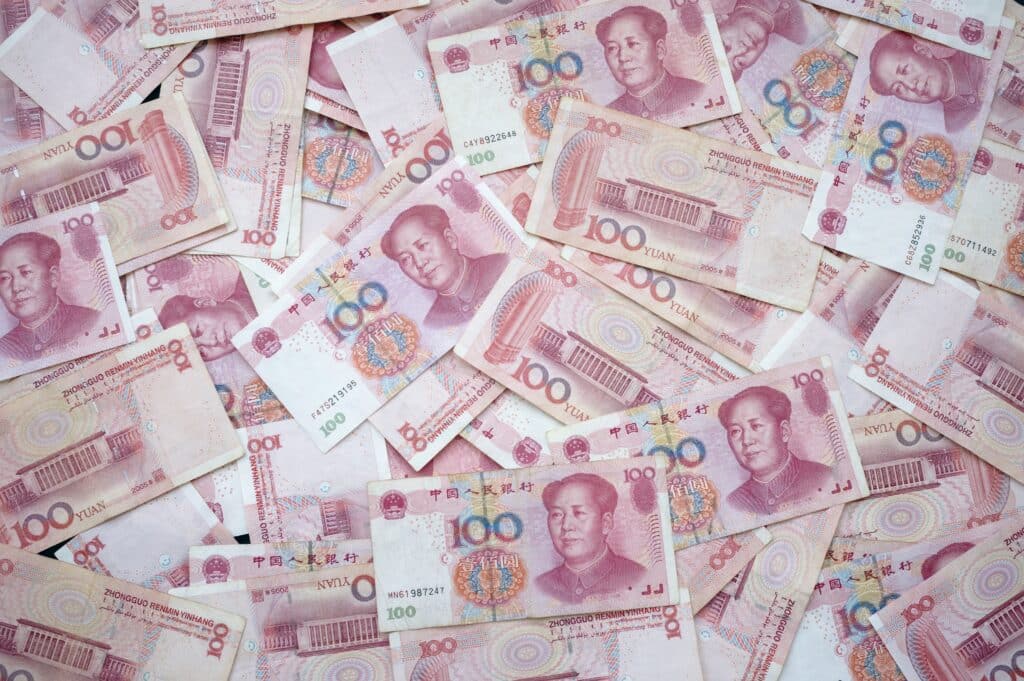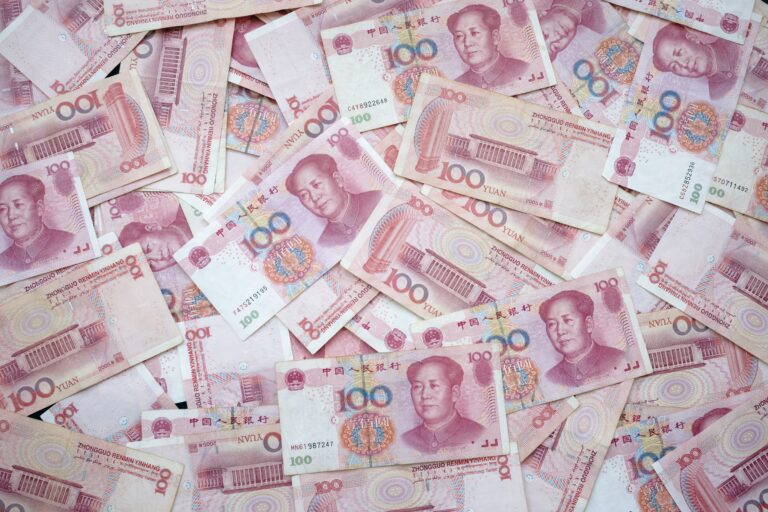Read on to discover facts about the Chinese Renminbi, the official currency of the People’s Republic of China. What’s the difference between RMB and yuan? Get answers and more about the eighth most-traded currency globally.
Chinese Renminbi Overview
The official currency of China is known as the renminbi (RMB), but it is also commonly referred to as the Chinese yuan (CNY).
Renminbi is the name of the currency itself while yuan is the actual unit of currency. This is quite similar to the UK’s pound sterling and pound.
The word “yuan” comes from the Qing Dynasty era. It literally translates into “round object” or “round coin.” One yuan can be further divided into jiao and fen, which is similar to a cent used in the U.S.
However, in everyday Mandarin, people don’t use renminbi or yuan when talking about money. Instead, they use the word “kuai.” Kuai (Chinese: 块; pinyin: kuài) is usually used when discussing money.
6 Facts About the Renminbi
1. Denominations
The renminbi currency comes in denominations ranging from 1 fen to 100 renminbi. The banknotes include imagery of some of China’s communist leaders, both past and present, including Mao Zedong.
Popular political figures appear on larger denomination bills, and people in traditional, formal Chinese attire appear on the lower denominations.
The renminbi is available in denominations from:
- ¥0.1
- ¥0.5 (1 and 5 jiao)
- ¥1
- ¥5
- ¥10
- ¥20
- ¥50
- ¥100
Coins are available from 1 fen to 1 yuan (¥0.01–1). As prices rise, some low denomination coins and bills are no longer used.
2. The fixed rate
From 1949 until the late 1970s, China placed an overvalued fixed exchange rate on its currency. The Chinese government did not want the country to depend on the outside world for imports.
In an effort to boost its own industrialization, the fixed rate allowed them the opportunity to buy machinery from other countries at prices they could afford.
This is what enabled China to advance as an industry leader in the global economy, and it is also why Chinese currency moves in the same direction as the U.S. dollar (USD).
3. The equilibrium value
In 2012, appreciation actions by the Chinese government, as well as quantitative easing measures taken by the American Federal Reserve and other major central banks, have caused the renminbi to be within as little as 8% of its equilibrium value.
4. IMF reserve currency
On October 1st, 2016, the RMB became the first emerging market currency to be included in the IMF‘s special drawing rights basket, the basket of currencies used by the IMF as a reserve currency.
5. Devaluation
The International Monetary Fund stated that the Chinese currency is no longer undervalued against the dollar given its recent appreciation, however, economists stated that recent devaluations as of 2019 may change that outlook.
6. Digital Renminbi
In October 2019, China’s central bank, PBOC, announced that a digital renminbi is going to be released after years of preparation.

History of Chinese Currency
China is a nation with centuries-old history. As far back as 210 BC, China was using currency similar to what we use today, rather than simply trading goods with the barter system.
The first emperor of China Qin Shi Huang dismissed the trading currency of the time and replaced it with copper coins. It wasn’t until the 9th century that paper money was introduced into China’s currency. Even then, the copper coin remained a staple in China’s currency offerings.
In ancient China, coins of gold, silver, and lead were used. Different values were made in different sizes, different weights, and bore different symbols.
An ancient trading nation, China was among one of the first nations to use a form of currency similar to the modern currency we now use.
History of Chinese Yuan Renminbi Banknotes
The first series
The first series of renminbi banknotes were issued in 1948 by the People’s Bank of China.
The second series
In 1955, the second series of notes were printed in Tibetan, Mongolian, and Zhuang languages.
The third series
In 1962, the size and design of the denominations changed.
The fourth series
From 1987 to 1997, the fourth series was printed, and it went out of circulation in 2019.
The fifth series
The fifth and most current series of banknotes and coins offers a new design and style than the previous series.
The production of the renminbi takes place at the China Banknote Printing and Minting Corporation (CBPMC), which has its headquarters in Beijing. It has continued to update the currency to make it even more difficult to counterfeit.
Understanding Renminbi Currency Exchange Rates
When using or sending money abroad, it is also important to keep foreign exchange rates in mind. You have many options for checking exchange rates for the American dollar (USD), the Canadian dollar (CAD), the euro (EUR), the Australian dollar (AUD), the British pound (GBP), and others to Chinese yuan (CNY).
Check the current rates with Remitly in our app or on our website.
The exchange rate is based on the value of the renminbi in comparison to the value of the currency you are exchanging to. Exchange rates vary based on several economic and political factors, from global trade to national elections to interest rates.
You can also find current exchange rates with an online currency converter or by checking with your bank or money transfer app of choice.
More About the People’s Republic of China
With a population of 1.4 billion, China is the most populated nation in the entire world. China spans five time zones and includes 14 geographical countries.
The People’s Republic of China is a communist nation currently run by the Communist Party of China. It came into power on October 1, 1949, under the leadership of Mao Zedong. Chinese leadership maintains that private capitalists and entrepreneurs work collaboratively with public and collective enterprises.
China is an industrial superpower in the world. It provides materials and finished products to most of the world. Many countries are entirely dependent on Chinese exports. China accounts for nearly 30% of global manufacturing. China’s most popular exports are broadcasting equipment, computers, machine parts, phones, and electronic devices.
As a modern-day industrial superpower, China employs millions of citizens in the production and manufacturing industry. The country is leading the way in technological advancements. In addition, China is opening many jobs to immigrants, including roles in education, media, engineering, and the tourism industry.
Some major cities in China include Beijing, Shanghai, Chongqing, Tianjin, and Guangzhou.

